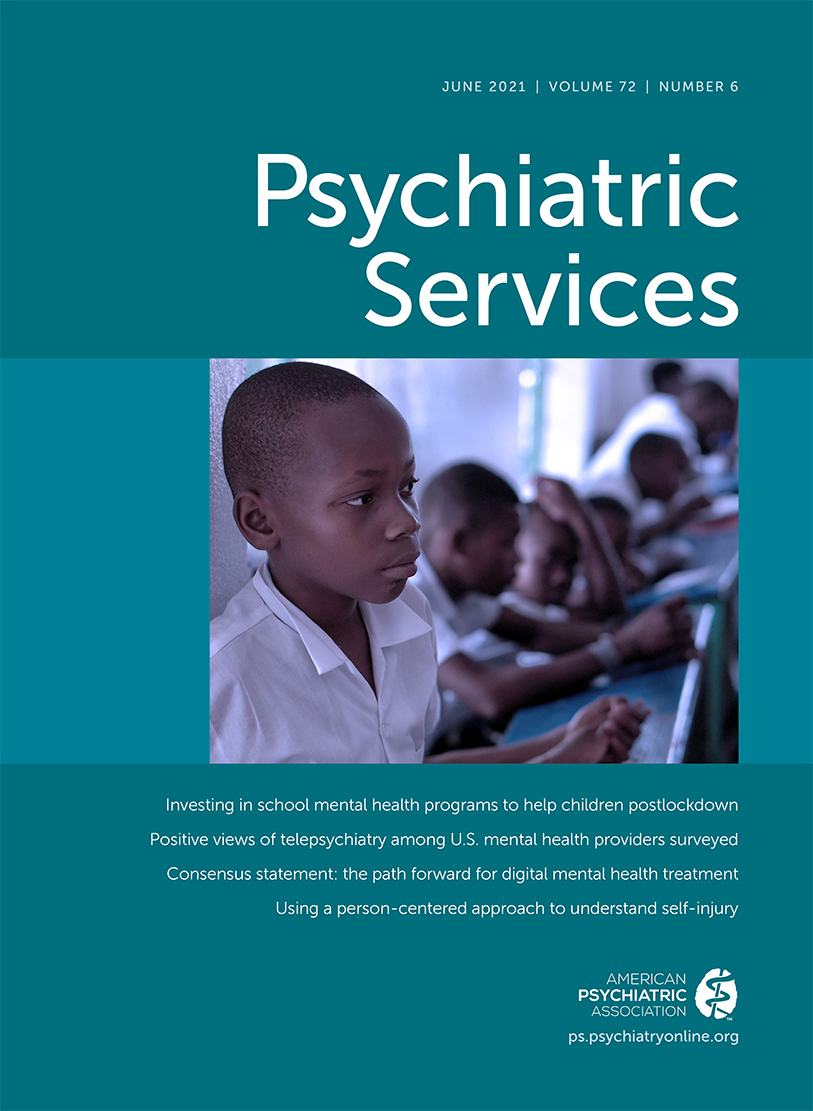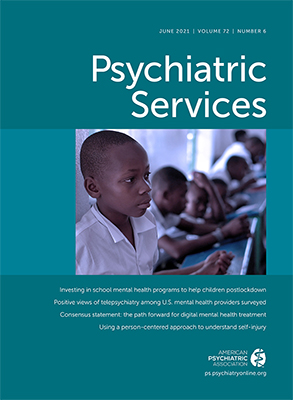Rural mental health service areas often lack evidence-based practices (
1). In addition to a shortage of professionals (
2), rural providers work with clients who must cope with poverty, limited educational opportunities, job loss as a result of economic shifts, unemployment, family stress, substance abuse, and social isolation (
3). Moreover, some evidence-based practices do not easily transfer from urban to rural mental health service areas. Even practices that are widely used in rural areas must adapt to local contexts, which vary considerably from one area to the next (
4–
7).
Evidence-based supported employment, also called individual placement and support (IPS), substantially enhances social recovery and has become a core mental health service in the United States and many other high-income countries (
8). Rural IPS programs in the IPS learning community achieve employment outcomes that are comparable to those in urban and suburban areas (
9). In this study, we explored how rural providers have adapted IPS. Our aim was to inform federal, state, and local policy makers, trainers, and providers who are considering the implementation of IPS in rural areas.
Methods
State mental health and vocational rehabilitation leaders nominated IPS specialists from successful IPS programs in 15 states. National IPS trainers confirmed these specialists’ expertise and the success of the programs they supervised. We conducted interviews with 27 key informants who had knowledge of and experience with IPS (trainers, supervisors, and specialists). Regions included Appalachia, Midwestern farming states, mountain areas, northern New England, the Southeast, the Northwest, and the Southwest. The rural areas differed in terms of degree of rurality, type of industries, and number of individuals from racial-ethnic minority groups, immigrants, and Native Americans.
The interviewer (R.E.D.) started with one question: “What are the barriers to delivering IPS in rural areas and how do you overcome them?” Follow-up questions probed for expansions on answers, for example, “Tell me more about how you overcome stigma in your area.” The interviewer documented participants’ responses with detailed notes, including verbatim quotations.
Two authors (M.A., R.E.D.) independently reviewed the interview notes manually to generate initial lists of issues relevant to adapting IPS services in rural areas. Through discussions with a third author (E.C.-S.), the team identified points of overlap and unique issues noted in the initial review to construct a more complete catalog of key concepts and categories in the data set. Qualitative codes reflected both a priori categories driven by the research question (e.g., barriers to IPS delivery) and categories that were developed through inductive review. The team worked collaboratively to synthesize prominent themes, by using standard methods of thematic analysis, and stopped interviewing when it reached saturation of themes (
10). To enhance the rigor of interpretations, we used multiple researchers, all familiar with mental health and IPS, to allow for multiple perspectives (
11). We also selected emblematic quotations to illuminate the main themes. The study was reviewed and approved by the Westat Institutional Review Board. All interviewees gave verbal consent for participation.
Results
All interviewees stressed that IPS is effective in rural areas but that providing IPS services in rural communities presents a variety of challenges. They converged on similar challenges and recommended diverse local adaptations (
Table 1). None of the recommended adaptations altered basic IPS principles, such as service integration, following client preferences, in-person job development, rapid job search, and follow-along supports (
12).
Large Distances, Lack of Public Transportation, and Lack of Internet Connectivity
Nearly all interviewees mentioned the lack of available public transportation. Where public transportation was available, it was unreliable, often did not reach clients’ residences, or was unavailable on weekends. In addition, IPS specialists often needed to travel long distances to see their clients. Although the use of technology might seem to be an ideal solution, many IPS clients also lacked Internet connectivity or necessary technological tools.
To travel to and from work, IPS clients relied on natural supports, such as family members and church members, ride sharing with coworkers, and, when available, a Medicaid waiver to support access to work. IPS specialists helped clients purchase bikes and purchase or repair cars. In some instances, they helped clients become drivers to transport other clients for pay. Sometimes IPS specialists temporarily transported their clients when they began a job until the clients arranged rides with coworkers. Some clients found remote jobs; others moved closer to their workplace, walked long distances, or rode a bike. When clients had to apply to jobs online but lacked a computer and Internet connection to do so, they applied with the help of their IPS specialist by using a computer available at the health center or library. More recently, the need for connectivity through technology has been further exacerbated as a result of COVID-19.
Limited Job Opportunities and Closeness of Business Ownership
The limited number of available job opportunities challenged many rural IPS providers. Most jobs depended on local industries, which varied from state to state (e.g., factories in rural Ohio and farms in rural North Dakota). To match clients’ job preferences, IPS specialists sometimes collaborated with employers to carve out part-time jobs or with clients to start their own business.
The lack of available opportunities affected frontier areas more severely. Several interviewees stressed that rural towns at least had a few employers and were perhaps close to a large factory or distribution center, but more remote frontier areas had almost no employers. The employment choices in remote areas were simple: work on a local farm or ranch, work remotely (often impossible because of the lack of Internet access), or move to a more populous area.
A common refrain was that in rural areas “everybody knows everybody.” The lack of anonymity had disadvantages and advantages, sometimes enhancing bias against hiring people with mental illness, substance abuse, or justice system involvement and sometimes leading neighbors to help neighbors. Relationships with employers were critical. Employment specialists reported greater success in developing jobs at locally owned businesses; this was more challenging with chain stores with distant owners and headquarters, especially for clients who did not want to disclose their mental illness. One way that IPS specialists developed relationships with local employers and enhanced awareness of recovery potential was to network regularly with employers in restaurants, coffee shops, or business group meetings.
Limited Funding and Workforce Availability
Hiring and retaining IPS workers in rural areas can be difficult, especially in mental health centers with low pay and in areas with few professionals. Funding regulations through managed care have resulted in serving some clients without reimbursement, thereby stressing mental health center budgets. Waitlists have resulted in more rural clients receiving fewer services than those who live near towns. Strategies to overcome these challenges included equalizing pay between care managers and IPS workers. In addition, strong leadership and training resulted in high retention. Hiring local residents without professional education required more training, but these IPS workers valued the jobs and had longer tenure.
Relationships with local vocational rehabilitation (VR) were often helpful, especially when the state VR cut funding. Others experienced challenges with obtaining VR approvals and with communication because of the long distance needed to travel to the nearest office. In such cases, technology sometimes helped overcome communication challenges.
Local Culture
Culture varies from one rural area to the next. For example, local culture can emphasize welcoming or discriminating against immigrants, trying to replace a declining industry such as mining, or understanding Native American governance structures. Adaptations also varied. For example, in the five states with Native American reservations, IPS specialists made adjustments for local business ownership by the tribal council; local values, such as maintaining strong family ties; and local regulations, such as, on one reservation, the prohibition of hiring any members with a substance use disorder.
Once again, relationships were critical in all rural communities. IPS workers were more effective when they were residents in the community, knew the local families and culture, could relate to local employers, and were able to navigate local intricacies.
Discussion
The successful implementations of IPS in rural settings that are highlighted in this report demonstrate the viability of implementing IPS to address the need of rural mental health service areas for evidence-based practices. Although the IPS interviewees shared some similarities in the challenges they faced, the strategies they used to overcome these challenges differed from one area to the next. For instance, a majority of those interviewed mentioned the lack of available public transportation, but the alternative methods of transportation used differed on the basis of local resources. Many interviewees also mentioned the lack of local employment opportunities, but their responses reflected the local job market, including local trades and their seasonality as well as relationships with potential employers. Small team size sometimes reduced fidelity scores. We found the lack of anonymity in rural areas to be dual in nature, posing challenges of bias against clients but also helping to strengthen relationships with employers. Rural communities have different cultures; some sites are involved with Native American reservations, and others serve a sizable population of immigrants and refugees. These differences, in turn, have affected local employment patterns generally and the types of jobs clients seek individually.
Such findings highlight the importance of local knowledge, which IPS workers must understand and consider when implementing mental health and vocational interventions (
13). Adoption of IPS requires adaptation; in rural areas, we consistently found that adaptations of the model were specific to the local area but did not change any of the core principles of IPS. The model remained personalized, client centered, direct, and integrated with behavioral health care (
14).
Implementing IPS in rural areas may be easier than implementing other evidence-based practices in rural settings, because IPS was developed in a rural state and has been demonstrably effective in rural areas (
12). Other community-based interventions, such as assertive community treatment, have undergone varied modifications for use in rural settings that rendered the services provided less intensive than the standard model and without empirical validation (
15).
Our findings reflect interviews with IPS experts in rural states within the IPS learning community. We did not include rural states outside of the learning community, where different challenges and strategies may exist but where evidence of effectiveness could not be confirmed. Moreover, our interviews focused on identifying challenges and solutions to providing IPS in rural areas. Future research could also address facilitators, such as the ease of integrating mental health and employment services. Findings from this exploratory study suggest that specific strategies should be shared and examined across additional rural areas.
Conclusions
Rural communities across the United States are fraught with limitations in public transportation, Internet connectivity, employment opportunities, and other challenges. Nevertheless, IPS supported employment can be effective in rural areas. Although these communities contain different cultures and have varying adaptations to IPS, successful implementations of IPS preserve the principles of the model. IPS should be a core behavioral health service in the rural United States.

